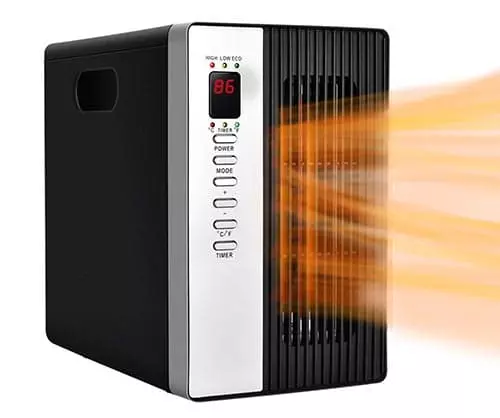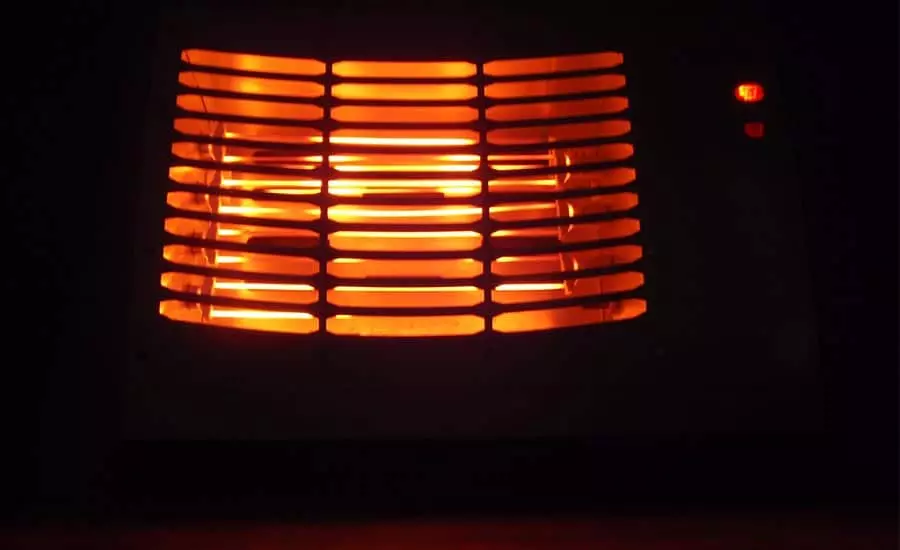Are infrared heaters and radiant heaters the same or is there a difference? If there’s a difference: Which one is better? This is actually a topic that confuses lots of people.
Even though I am an electrical engineer I was sitting in front of my screen thinking: “Is there even a difference between infrared and radiant heat”?
In this article, we’re going to uncover the truth that baffles even engineers. After reading this you’ll have a solid knowledge of what radiant and infrared heaters are and why they are called like this.
But first, here’s the quick answer.
Question: Are infrared heaters the same as radiant heaters?
Answer: Absolutely. Infrared heaters and radiant heaters are the exact same thing. The word “radiant” indicates that the heat is generated with radiation, whereas “infrared” just specifies which kind of radiation is used. You could say “radiant heater” is a broader term, but in practical applications infrared is the only kind of radiation you use to heat your home. All infrared heaters are radiant heaters.
Surprising? Well, it actually surprised me. I didn’t think that radiant heaters and infrared heaters are the same. I believe that you can easily confuse the term “radiant” with radiators, which don’t use radiation directly to produce their heat. That’s where the confusion oftentimes comes from.
Let’s clarify a few things.
Why are they the same?
Infrared heaters and radiant heaters are one and the same. The term “radiant heater” tells you that some kind of radiation is used to heat up a room. Whereas the name “infrared heater” specifies that infrared radiation generates the heat.
Generally, the radiation that we perceive as warmth is always infrared heat.
This means that radiant heat is just a broader term for infrared heat.
All heaters are radiant heaters (from a physicists perspective)
In fact, all heaters are radiant heaters. Oil-filled space heaters and ceramic space heaters are radiant heaters as well. Why?
Each object that has a temperature emits infrared radiation. When the infrared waves hit another object, the other object absorbs the radiation and heats up.
One good example are sun rays. Sun rays consist of many wavelengths including infrared. The infrared part of the spectrum is what warms you.
Small and interesting side note:
Sunlight contains a broader spectrum of wavelengths, ranging from infrared to ultraviolet (UV). The UV part gives you sunburn. That’s the reason you can’t get a sunburn from your space heater, radiator or in a sauna: The warmth there is pure infrared radiation.
 The range of visible light: From UV (left) to infrared (right)
The range of visible light: From UV (left) to infrared (right)
The warmth you perceive is always infrared radiation. It doesn’t matter where the heat comes from. Whether it’s from an infrared heater or a ceramic heater doesn’t matter.
Think of it like this:
Imagine you point an infrared thermal camera (heat cam) at a ceramic heater. Would it light up? Yes, it would!
Because the heater is hot, it radiates infrared waves!
Basically, infrared is just the same as heat (independent of the heat source).
Advantages of Infrared or Radiant Heaters
Because infrared or radiant heaters use radiation instead of convection (the movement of air) to distribute heat, they come with some very useful advantages over regular heaters. Here are some of them:
Focused heat- Infrared or radiant heaters don’t heat air, they heat objects. This means that infrared or radiant heaters can aim the radiation on any spot in your room that you like. You can use this focused heat area to keep a certain spot in one room warm and comfortable.
This is useful when you have a big room (a garage) and you want to be working just at your desk. With an infrared or radiant heater, you can aim the heater towards that desk to keep just this area warm.
Energy efficiency - Infrared and radiant heaters are energy efficient. The energy is bundled in infrared rays and reaches every spot you desire to heat. In contrast to regular space heaters, very little energy is wasted to heat unnecessary areas in your room.
Durability - Infrared and radiant heaters don’t have any moving objects, which makes them very durable. There’s just nothin that can wear down.
Silence- My favorite aspect of infrared heat is that it is silent. No fan is necessary to distribute the heat. Although some radiant heaters come with a fan, it is not necessary to use it. This makes it perfect for everyone who wants to concentrate or calm down.
Design- This is just my personal opinion, but I think radiant heaters look really really good. You can fit their design anywhere. It gives your room a bit of a manly vibe because you have these glowing orange-red radiator parts.

Disadvantages of infrared and radiant heaters
When you get an infrared or radiant heater there are some tradeoffs as well. They are not always suited for all purposes. This list helps you decide whether radiant heaters are something for you or whether you should keep looking.
Some are not suited for heating big rooms- Some infrared and radiant heaters (usually the smaller ones) don’t distribute heat well. They are great for focused heat (for example keeping you warm on your couch) but perform not as great as other heaters when you want to heat an entire living room.
It makes sense to only get infrared or radiant heaters when you are sure you just want to keep a spot warm.
After some time the temperature in a whole room will rise as well, but it’s not as fast as with other heaters.
“Radiant heaters emit infrared radiation that directly heats objects and people within their line of sight, and are a more efficient choice when you will be in a room for only a few hours and can stay within the line of sight of the heater.” energy.gov about portable heaters
Note: This downside is only valid for small infrared heaters. You can, of course find infrared heaters that are priced a little higher, which will heat up your room effectively (like the one I recommend in the section below). These heaters are usually bigger in size and cost a little more.
- Hot to touch- Infrared and radiant heaters have a hot emission area where the infrared rays come out. This area is oftentimes hot to touch. Therefore, you should be careful with children and pets in that case.
However, modern heaters usually have some kind of protection to minimize the risk of touching the hot metal grid. A lot of modern devices don’t even get hot on the outside at all.
Which radiant or infrared heater should you get?
Here’s my favorite infrared heater that comes without the disadvantages: It is not hot to touch and it is well suited for big rooms!
Portable Infrared Heater by TaoTronics(click here to check the price on amazon)- A radiant heater with everything a good heater needs: Overheating protection so you can leave it on in your absence, tip-over-protection, built-in shutoff timer, suited for heating whole rooms.
“Keeps my entire downstairs nice and toasty.”
a reviewer on amazon
Conclusion
Infrared and radiant heaters are the same. Both use infrared radiation to heat up objects in your room.
Small radiant heaters are well suited for heating up limited areas while bigger heaters can heat up entire rooms. Consider this when buying an infrared heater.
Infrared and radiant heaters are very energy-effective. They can directly heat objects within their line-of-sight and don’t need a fan to distribute the heat.
Attributions: Title photo by i kwan (flickr)
